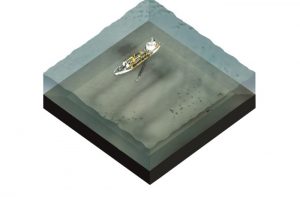Practical Applications
Examples are:
- Gravel-seeding techniques to restore the seabed to pre-dredge conditions after gravel extraction in the English part of the North Sea (Cooper et al., 2011). Changes in bed shear stress values after sand extraction also the main drivers of ecological changes although not yet fully recognised. Optimisations in bed shear stress values, by fine-tuning extraction depths and orientations of the sand extraction sites with respect to the tidal current are possible (e.g. to prevent against sedimentation which may be harmful to hatching herring larvae on the gravelly seabed).
- Seine estuary cooperation between dredging and fishing industries (Desprez, 2000; Marchal et al., 2014). Optimisations in bed shear stress values, by fine-tuning extraction depths and orientations of the sand extraction sites with respect to the tidal current are possible.
- Maximum allowable changes in seabed level and bed shear stress values after sand extraction to maintain original macrozoobenthic characteristics (poster and oral sessions of Koen Degrendele and Dries van den Eynde at the ICES Annual Science Conference 2016) http://www.ices.dk/news-and-events/asc/ASC2016/Pages/Theme-session-K.aspx
- Maintenance dredging in river and estuarine systems (Yuill et al., 2016).
- Rijke riffen (van Duren et al., 2016), Building with North Sea Nature: eco-friendly scour protection (Lengkeek et al., 2017) and construction of artificial reefs in Japan (Thierry, 1988).
- Rejuvenation dredging of tidal creeks in a mangrove systems (Bonaire and Curaçao). Rehabilitating mangrove belts and Ecological rehabilitation Lac Bay Mangroves, Bonaire
Specifically, more information on the lessons-learned from the Maasvlakte 2 practical example are given below, discussing a range of factor around the project planning, execution and evaluation
Lessons Learned
During the project, new insights were gained concerning technical and ecological aspects of the design and the organisation of a large-scale and deep sand extraction project with ecosystem-based sand bars.
The project also generated a broad discussion amongst the various stakeholders on how changing physical conditions can trigger ecological development of new habitats.
The most important lesson learned is that seabed landscaping in sand extraction sites only makes sense if:
- the sand extraction volume and sand extraction site is large enough for landscaping to have added value;
- landscaping is indeed expected to yield added ecological value; and
- landscaping can be carried out during the extraction process without additional equipment mobilisation and with minimal hindrance to the production process. Overall, it became clear that it is still too early to prescribe or promote landscaping to other sand extraction projects, even if they meet the above described conditions. The seabed and assemblages are not yet in a stable state so the added ecological value remains to be proven.
Few of the other learned on project realisation are:
- Take a joint approach involving all stakeholders, from initiator, consultant (technical) experts and contractor to permitting authority.
- Make sure the decision to include ecosystem-based landscaping is taken early in the (design) process.
- Use expert knowledge and numerical models to predict the behaviour of the bedforms in the sand extraction site to make sure that they are relatively stable and allow sufficient time for ecological development.
- Make sure that there is enough space around the bedforms for the dredging equipment to manoeuvre.
- The extraction depth influences the potential of the landscaped area. If the extraction is too deep, the effect of morphological landscaping may be dominated by the hydrodynamic effects of the deep pit (e.g. high sedimentation rate).
- Discuss and investigate the potential of landscaping in a certain extraction area within the prevailing permit limitations before the design is made (input for design);
- Ensure frequent updates of the bathymetry of the created bedforms, in order to be able to monitor their development and steer expectations among stakeholders. Morphological monitoring will enable evaluation of the design, predict the longevity and assess the effectiveness of reaching the original goals (e.g., increasing biodiversity or biomass).
- Apply adaptive processes to the ecological monitoring strategy: tune next monitoring to developments found at previous efforts, while still maintaining consistency in data collection for good comparison objectives.

